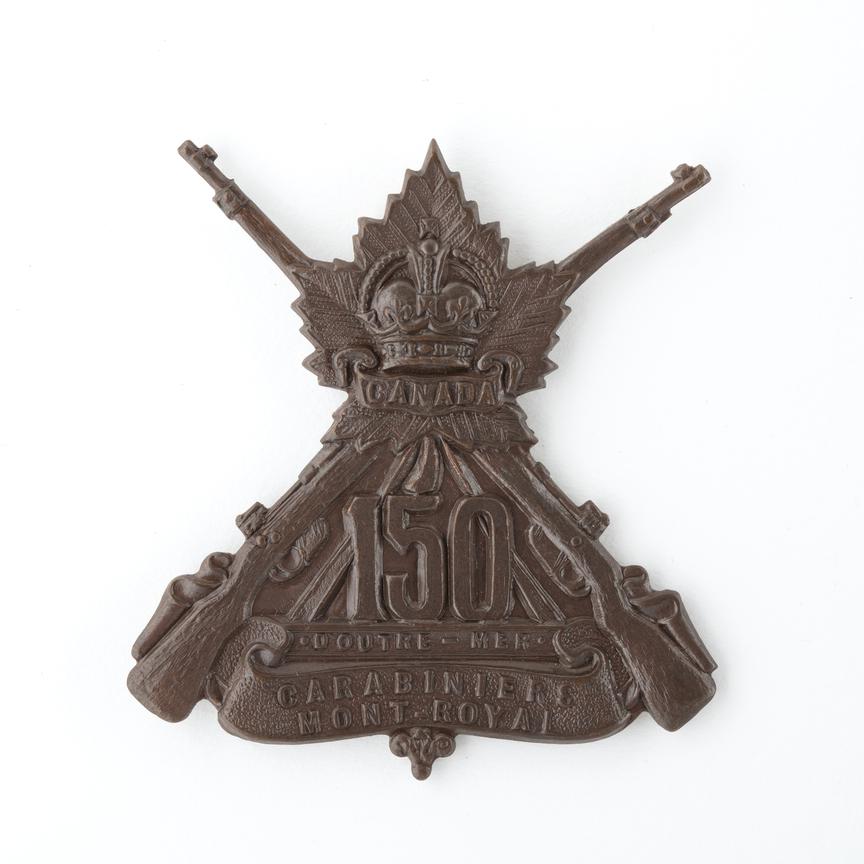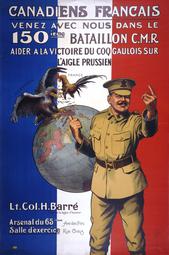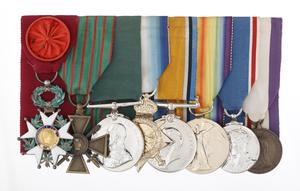Unit
150th Canadian Infantry Battalion (Carabiniers Mount Royal)
Branch
Infantry
Service Component
Canadian Expeditionary Force
Service Number
26269
birth
1879/03/31
Montréal, Quebec, Canada
death
1943/12/30
Montréal, Quebec, Canada
grave
Cimetiere Notre Dame des Neiges, Montreal
Gender
Male
Hercule Barré was born on 31 March 1879 in Montreal to Louis-Joseph and Marie Barré. The 1881 Census shows him in Montreal, the 5th of 6 children. By 1901 he is still living there with his father and one other brother. Hercule shows up on the pay list of the 65th Militia Battalion (Carabiniers Mount Royal) as a private in 1897. By 1905 he attended the Royal School of Infantry in Saint John, PQ, as a Lieutenant and two years later took his Captain’s course. He became a captain in 1909. His civil occupation was an advertising agent.
When he joined the Canadian Expeditionary Force (CEF) on 23 September 1914, Barré indicated that his parents were dead and that he was the sole support of his sister and her daughter. He joined the 14th Canadian Infantry Battalion, sailing for the United Kingdom in late September and arriving 19 October. By 22 October the unit was in Salisbury Plain for training. Barré arrived in France on 31 March 1915 and joined his unit, which by this time was already in the trenches at Armentieres. The 14th Battalion got caught up in the 2nd Battle of Ypres where, on the 22 April 1915, while they were in billets at St Jean, they noted “heavy shelling of Ypres” and were ordered to stand to. The unit then took up positions in the General Headquarters line near the Ypres/St Julien Road. The next day it was ordered to move up to reinforce the 16th Battalion but, before they arrived, the situation was deteriorating and the 14th Battalion went in to shore up the flank of the 13th Battalion. By the 24th of April both units were under heavy shell fire and the War Diary notes that both Battalions had “been literally blown out of the trenches”. They fell back and rallied behind a ridge, occupying whatever cover they could until they came under heavy fire from advancing German troops. It was during this time that Captain Barré received a gunshot wound to his right thigh impacting the pelvis. By the time the situation stabilized the 14th had suffered heavy casualties.
Barré was evacuated to the United Kingdom. for medical treatment where, according to Barré, an unsuccessful operation failed to remove the bullet. He was sent back to Canada on convalescent leave where a medical board found him unfit for field duty. By 18 December 1915 he was on home duty with the 150th Canadian Infantry Battalion (Carabiniers Mount Royal) in Quebec. He was promoted to Major and eventually to Lieutenant Colonel. However, when the 150th was disbanded to become the 10th Reserve Battalion, he relinquished command. While in Canada he was gazetted to the Legion of Honour of France in March 1916. Barré returned to France in January 1918 and took a reduction in rank to Major to go back to the field, joining the 22nd Canadian Infantry Battalion (French Canadian). He also served briefly with the 23rd and by November 1918 he was transferred to the 87th Canadian Infantry Battalion (Canadian Grenadier Guards). He returned to the United Kingdom on 7 May 1919 and sailed for Canada at the end of that month. On 10 June 1919 he was stricken from the CEF and nominally returned to his Militia unit, the 65th.
Barré’s medal card indicated that he initially intended to reside in Montreal after demobilization but the address for medal delivery was changed to Paris, France. A Canadian Pacific lines passenger list noted him arriving in Liverpool on 31 December 1919 in the Empress of France from Canada, presumably on route back to France. In subsequent years there are passenger lists indicating that Barré travelled back to Canada via New York to go to Montreal several times - presumably to visit his sister. The last one, with no specific date, has him returning, again via New York, in 1940. He died in Montreal on 30 December 1943 and is buried at the Cimetiere Notre Dame des Neiges in Montreal.




